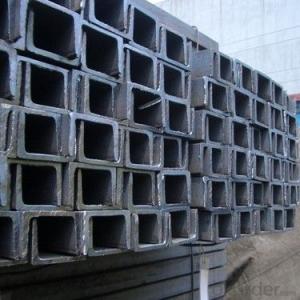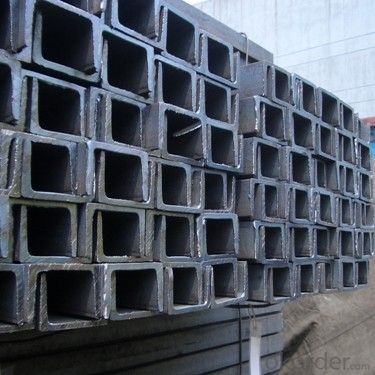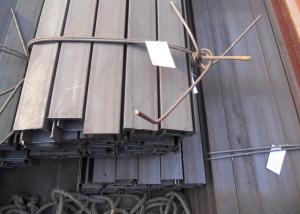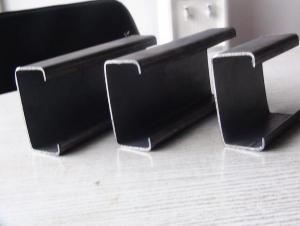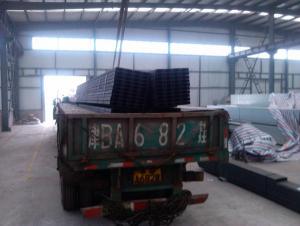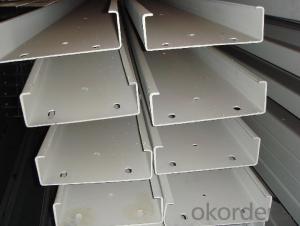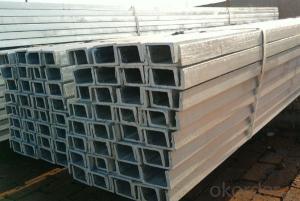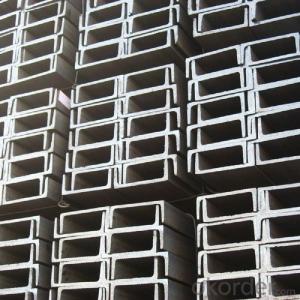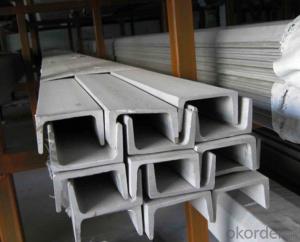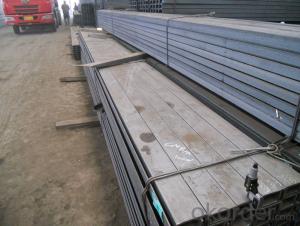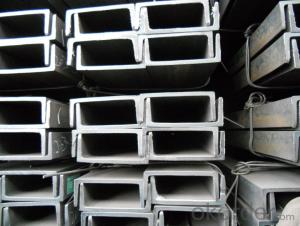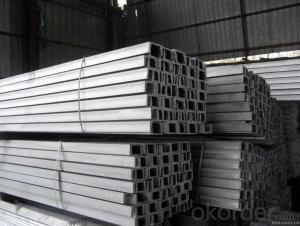JIS SS400 Steel Channel with High Quality 125mm
- Loading Port:
- Tianjin
- Payment Terms:
- TT OR LC
- Min Order Qty:
- 25 m.t
- Supply Capability:
- 10000 m.t/month
OKorder Service Pledge
OKorder Financial Service
You Might Also Like
JIS SS400 Steel Channel with High Quality 125mm
Product Description:
Standard: JIS
Material: SS400
Length: 6m, 12m
Size:
Size (mm) | Mass (Kg/m) |
125*65*5.2 | 11.66 |
125*65*5.5 | 12.91 |
125*65*6.0 | 13.40 |
Package & Delivery of JIS SS400 Steel Channel with High Quality 125mm:
1.The hot rolled channel steel will be packed in bundle with steel wire at each end of every bundle and color marking in order to help the customer to recognize his goods more easily at sight.
2. And the hot rolled channel steel could be loaded into 20ft or 40ft container, or by bulk cargo.If the weight of each bundle reaches more than 3.5 mt, the loading by break bulk cargo should be choosed.When the weight of each bundle reaches less than 3mt, the loading by container should be choosed.
3.As for the transportaion from mill to loading port, the truck will be usually used. And the maximum quantity for each truck is 40mt.
4.All in all, we could do in accordance with customer's request.
Production Flow of JIS SS400 Steel Channel with High Quality 125mm:
1.The steel billet shall be heated in the high temperature furnace.
2. The heated steel billet shall be rolled five to nine times with the aim of shaping the general figure of steel u channel.
3. The rolled steel channel should be put onto the cooling bed to make the temperature low.
4. The JIS Channel should be straighted on the straightener.
5. The straighted steel u channel will be cut into meters by saw, as per customer's requirements.
6. At the last part of production, the channel steel must be tested in order to confirm that the finished products are completely free from crack, pore, slag, scab or fold on the surface.
FAQ:
Q1: Why buy Materials & Equipment from OKorder.com?
A1: All products offered byOKorder.com are carefully selected from China's most reliable manufacturing enterprises. Through its ISO certifications, OKorder.com adheres to the highest standards and a commitment to supply chain safety and customer satisfaction.
Q2: How do we guarantee the quality of our products?
A2: We have established an advanced quality management system which conducts strict quality tests at every step, from raw materials to the final product. At the same time, we provide extensive follow-up service assurances as required.
Q3: How soon can we receive the product after purchase?
A3: Within three days of placing an order, we will arrange production. The shipping date is dependent upon the quatity, how many sizes you want and the plan of production, but is typically 1 month to 2 month days from the beginning of production.
Images of JIS SS400 Steel Channel with High Quality 125mm:
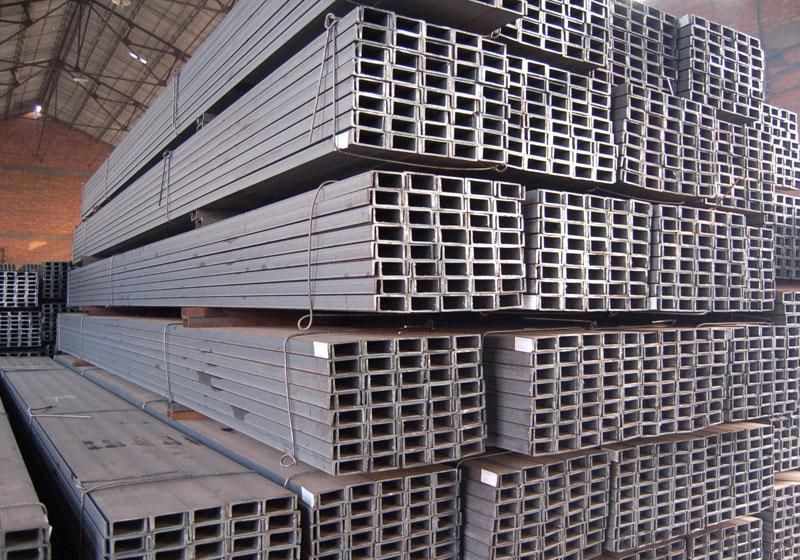
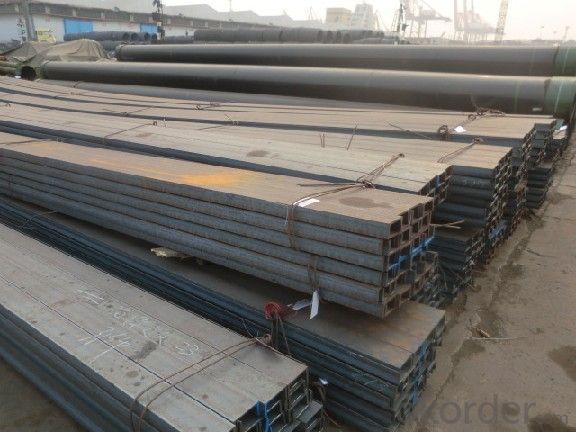
*If you would like to get our price, please inform us the size, standard/material and quantity. Thank you very much for your attention.
- Q: What are the common material testing procedures for steel channels?
- The common material testing procedures for steel channels involve various tests to evaluate the quality and properties of the material. Some of the commonly used testing procedures are: 1. Tensile Test: This test is conducted to determine the tensile strength, yield strength, and elongation of the steel channels. A sample is subjected to an increasing load until it fractures, and the stress-strain relationship is measured. 2. Hardness Test: The hardness of the steel channels is measured using methods like Rockwell, Brinell, or Vickers hardness tests. It provides an indication of the material's resistance to indentation or scratching. 3. Charpy Impact Test: This test evaluates the toughness and impact resistance of the steel channels. A notched sample is subjected to a high-velocity impact, and the energy absorbed is measured. It helps determine the material's ability to withstand sudden shocks or impacts. 4. Bend Test: This test is performed to assess the ductility and deformation behavior of the steel channels. A sample is bent to a specific angle without fracture, and the extent of bending is examined to ensure it meets the required standards. 5. Chemical Analysis: Steel channels undergo chemical analysis to determine the chemical composition of the material. This includes testing for the percentage of carbon, manganese, silicon, sulfur, phosphorus, and other alloying elements. It ensures that the steel meets the specified chemical composition requirements. 6. Ultrasonic Testing: Ultrasonic waves are used to detect internal flaws or defects in the steel channels. This non-destructive testing method helps identify any cracks, voids, or inclusions that may compromise the quality or structural integrity of the material. 7. Dimensional Inspection: The dimensions and tolerances of the steel channels are measured to ensure they meet the required specifications. This includes checking the width, height, thickness, and overall geometry of the channels. These material testing procedures are crucial in ensuring the quality, strength, and performance of steel channels, allowing them to be used confidently in various industries, such as construction, manufacturing, and infrastructure.
- Q: Can steel channels be welded together?
- Certainly, it is feasible to weld steel channels together. Welding serves as a prevalent technique in order to unite steel channels, thus establishing a robust and long-lasting connection. The process entails heating the steel channels until they reach their melting point and subsequently utilizing a filler material to amalgamate them. Depending on the specific necessities and the nature of the steel channels being united, welding can be executed through diverse techniques such as arc welding, MIG welding, or TIG welding. Nevertheless, it is imperative to guarantee the adherence to proper welding procedures and techniques to attain a weld of exceptional quality that meets the desired standards of strength and integrity.
- Q: What are the different design considerations for steel channels?
- Some of the different design considerations for steel channels include the load-bearing capacity, structural stability, material selection, the intended application or use, corrosion resistance, dimensional accuracy, and compatibility with other building components. Additionally, factors such as cost, availability, ease of fabrication and installation, and aesthetic appeal may also be taken into account during the design process.
- Q: Can steel channels be used in shipbuilding?
- Yes, steel channels can be used in shipbuilding. Steel channels are commonly used in the construction of ships due to their strength, durability, and versatility. They provide structural support and are used in various applications such as framing, stiffening, and reinforcing different parts of the ship's hull and superstructure. Steel channels are designed to withstand the harsh conditions at sea, including the impact of waves, corrosion, and extreme temperatures. They are also easily weldable, allowing for efficient assembly and repair processes. Overall, steel channels are an essential component in shipbuilding and play a crucial role in ensuring the strength and integrity of the vessel.
- Q: Are steel channels suitable for use in telecommunications infrastructure?
- Steel channels are a suitable option for telecommunications infrastructure. They are extensively used in various industries, including telecommunications, due to their strength, durability, and versatility. They serve as a stable and reliable support structure for telecommunications equipment such as cables, wiring, and antennas. The load-bearing capabilities of steel channels are excellent, making them an ideal choice for supporting heavy equipment and ensuring infrastructure stability. They can bear the weight and stress associated with telecommunications equipment, guaranteeing the safety and longevity of the infrastructure. Furthermore, steel channels possess high resistance to environmental factors like extreme temperatures, moisture, and corrosion. This resistance is particularly crucial in telecommunications infrastructure, which is often exposed to harsh outdoor conditions. By enduring these elements, steel channels ensure the integrity and functionality of the infrastructure. Moreover, steel channels can be easily customized and fabricated to meet specific project requirements. They can be cut, welded, and shaped to create the desired support structure, allowing for flexibility in the design and installation process. Additionally, steel channels offer cost-effectiveness compared to alternative materials. They are relatively affordable and readily available, making them a practical choice for telecommunications infrastructure projects. In conclusion, steel channels provide the necessary strength, durability, and adaptability required for telecommunications infrastructure. They effectively support equipment, withstand environmental conditions, and offer cost-effective solutions. Therefore, steel channels are highly suitable for use in telecommunications infrastructure.
- Q: How do steel channels contribute to sustainable construction?
- Steel channels contribute to sustainable construction in several ways: 1. Durability: Steel channels are highly durable and resistant to corrosion, which means they have a longer lifespan compared to other construction materials. This reduces the need for frequent repairs and replacements, resulting in less waste generation and lower environmental impact. 2. Recyclability: Steel is one of the most recycled materials globally, and steel channels can be easily recycled without losing their properties. Using recycled steel channels in construction projects reduces the demand for new steel production, conserves natural resources, and minimizes greenhouse gas emissions associated with manufacturing new steel. 3. Structural efficiency: Steel channels have excellent strength-to-weight ratio, allowing for the creation of strong and stable structures while using less material. This efficiency leads to reduced material consumption, lower transportation costs, and decreased energy requirements during construction. 4. Design flexibility: Steel channels offer design flexibility, enabling architects and engineers to create innovative and sustainable structures. Their versatility allows for the optimization of building layouts, efficient use of space, and integration of energy-efficient systems, such as solar panels or rainwater harvesting systems. 5. Energy efficiency: Steel channels can be used as part of energy-efficient construction systems, such as insulated wall panels or roof trusses. These systems help improve a building's thermal performance, reducing energy consumption for heating and cooling. Moreover, steel channels can support the installation of energy-saving technologies, such as LED lighting or smart building management systems. 6. Resistance to natural disasters: Steel channels provide excellent resistance to extreme weather events like hurricanes, earthquakes, and fires. Building with steel channels can enhance the structural integrity of a construction, making it more resilient and reducing the risk of damage or collapse during such events. In summary, steel channels contribute to sustainable construction by offering durability, recyclability, structural efficiency, design flexibility, energy efficiency, and resistance to natural disasters. These features help reduce environmental impacts, conserve resources, and create long-lasting, sustainable buildings.
- Q: What are the different methods for connecting steel channels?
- There are several methods for connecting steel channels, including welding, bolting, and using mechanical fasteners such as screws or rivets. The choice of method depends on factors such as the structural requirements, load-bearing capacity, and the desired level of flexibility or adjustability in the connection.
- Q: What are the sustainability benefits of using steel channels?
- Using steel channels has several sustainability benefits. Firstly, steel is a highly recyclable material, which means that it can be reused multiple times without losing its strength or properties. This reduces the demand for new steel production and minimizes the environmental impact associated with extracting raw materials. Additionally, steel channels are known for their durability and longevity, meaning that structures made with steel channels require less maintenance and have a longer lifespan. This reduces the need for frequent replacements and saves resources in the long run. Furthermore, steel channels are often lightweight, making them easier to transport and install. This leads to reduced energy consumption and emissions during transportation. Lastly, steel is resistant to fire, pests, and rot, which eliminates the need for chemical treatments and further contributes to a more sustainable construction approach. Overall, choosing steel channels can help promote a more sustainable and eco-friendly built environment.
- Q: Can steel channels be used in mezzanine floors?
- Yes, steel channels can be used in mezzanine floors. Steel channels are commonly used as structural elements in mezzanine construction to provide support and stability. They are strong and durable, making them suitable for supporting heavy loads and ensuring the safety and stability of the mezzanine floor.
- Q: How do steel channels contribute to the overall cost savings of a structure?
- Steel channels contribute to the overall cost savings of a structure in several ways. Firstly, steel channels are lightweight and easy to handle, which reduces transportation costs. Compared to other materials like concrete or wood, steel channels are more efficient to transport due to their high strength-to-weight ratio. This means that fewer trucks or containers are needed to transport the same amount of steel channels, resulting in lower transportation costs. Another cost-saving aspect of steel channels is their durability and long lifespan. Steel is highly resistant to corrosion, weathering, and pests, which means that structures built with steel channels require minimal maintenance and repairs over time. This reduces the need for costly maintenance work and extends the lifespan of the structure, resulting in long-term cost savings. Additionally, steel channels offer flexibility in design and construction. They can be easily customized and fabricated into various shapes and sizes, allowing for efficient use of materials and minimizing waste. This flexibility also contributes to faster construction times, reducing labor costs and overall project duration. Furthermore, steel channels are highly recyclable. At the end of a structure's life cycle, steel channels can be easily recycled and reused in other projects. This not only reduces the environmental impact but also provides cost savings by avoiding the need for new raw materials. Lastly, steel channels offer excellent structural performance, providing high strength and stability to the overall structure. This allows for the use of smaller section sizes, reducing material costs without compromising structural integrity. In summary, the use of steel channels in a structure contributes to cost savings through reduced transportation costs, low maintenance requirements, efficient use of materials, faster construction times, recyclability, and optimized structural performance. These factors make steel channels a cost-effective choice for construction projects.
Send your message to us
JIS SS400 Steel Channel with High Quality 125mm
- Loading Port:
- Tianjin
- Payment Terms:
- TT OR LC
- Min Order Qty:
- 25 m.t
- Supply Capability:
- 10000 m.t/month
OKorder Service Pledge
OKorder Financial Service
Similar products
Hot products
Hot Searches
Related keywords
